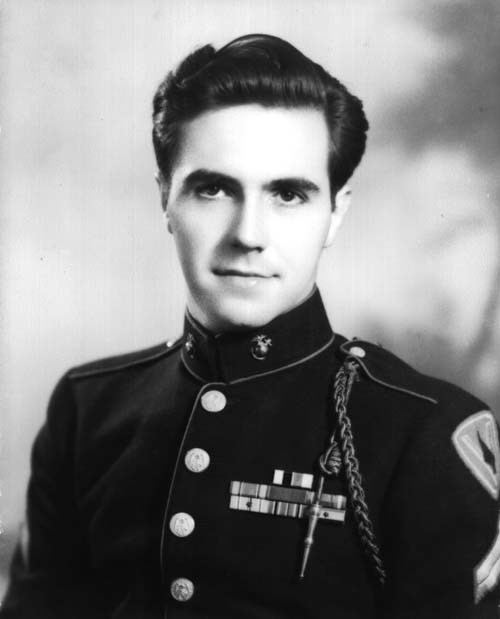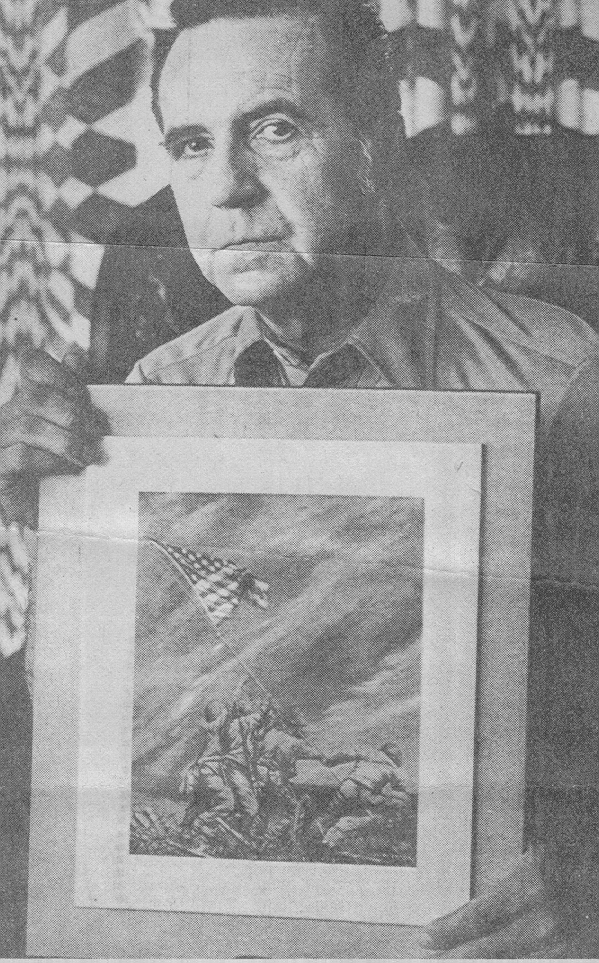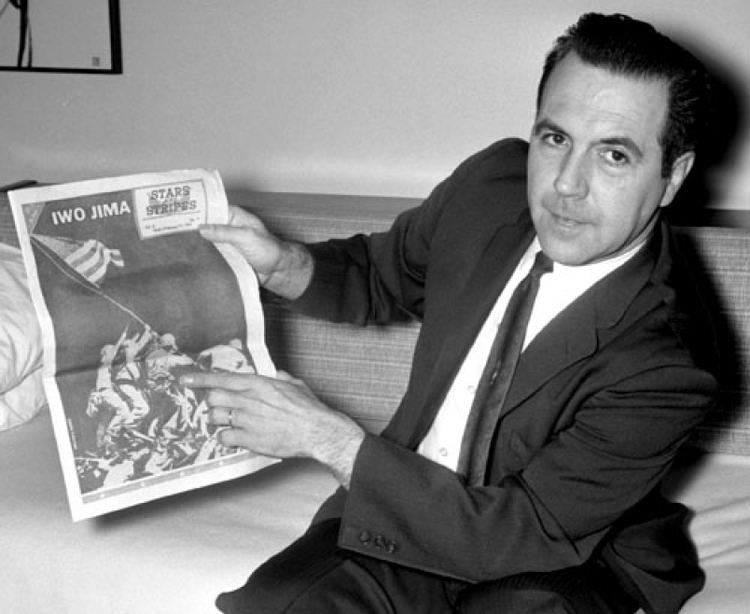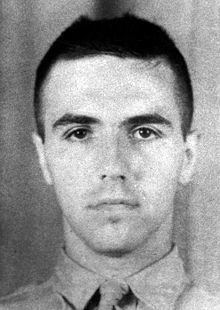Years of service 1943–1946 Rank Corporal | Name Rene Gagnon | |
 | ||
Born March 7, 1925Manchester, New Hampshire ( 1925-03-07 ) Allegiance United States of America Spouse Pauline Georgette Harnois (m. 1945–1979) Similar People | ||
Le peintre rene gagnon en malaisie partie 1 de 7
René Arthur Gagnon (March 7, 1925 – October 12, 1979) was a United States Marine Corps corporal who participated in the Battle of Iwo Jima during World War II. He is best known for being one of the six flag-raisers who helped raise the second U.S. flag atop Mount Suribachi on February 23, 1945 as shown in the iconic photograph Raising the Flag on Iwo Jima.
Contents
- Le peintre rene gagnon en malaisie partie 1 de 7
- The three surviving members of the iwo jima flag raising ira hayes rene gagnon hd stock footage
- Early years
- World War II
- Flag raisings on Iwo Jima
- Government war bond tour
- Marine Corps War Memorial
- Return to Iwo Jima
- Portrayal in films
- Death
- Military awards
- Public honors
- References

The Marine Corps War Memorial located in Arlington, Virginia, which was modeled after the flag-raising photograph, depicts bronze statues of each of the six Marine flag-raisers.

The three surviving members of the iwo jima flag raising ira hayes rene gagnon hd stock footage
Early years

Gagnon was born March 7, 1925 in Manchester, New Hampshire, the only child of French Canadian immigrants from Disraeli, Quebec, Henri Gagnon and Irène Marcotte. He grew up without a father. His parents separated when he was an infant, though they never divorced. When he was old enough, he worked alongside his mother at a local shoe factory. He also worked as a bicycle messenger boy for the local Western Union.
World War II

Gagnon was drafted in 1943, and elected to join the United States Marine Corps Reserve on May 6. He was sent to the Marine Corps Recruit Depot Parris Island, South Carolina. On July 16, he was promoted to private first class. He was transferred to the Marine Guard Company at Charleston Navy Yard in South Carolina and remained there for eight months. He then joined the Military Police Company of the 5th Marine Division at Camp Pendleton, California. On April 8, 1944, he was transferred to the 2nd Battalion, 28th Marine Regiment, 5th Marine Division. In September, the 5th division left Camp Pendleton for further training at Camp Tarawa, Hawaii, for the assault on Iwo Jima by three Marine divisions of the V Amphibious Corps (code named "Operation Detachment").
Flag raisings on Iwo Jima
On February 19, 1945, Gagnon landed on the southeast side of Iwo Jima with E Company, 2nd Battalion, 28th Marines on "Green Beach 1", which was the closest landing beach to Mount Suribachi on the southern end of the island. On February 23, Gagnon, a battalion runner (messenger) for Easy Company, participated in what was most likely the most celebrated American flag raising in U.S. history.
On the morning of February 23, a 40-man combat patrol (mostly from Third Platoon, Easy Company) was sent to climb up Mount Suribach and siege and occupy the crest. First Lieutenant Harold Schrier, E Company's executive officer, who volunteered to lead the patrol, was to raise an American flag on top to signal that the mountaintop was captured. Once Schrier and his men were on top, a Japanese iron water pipe was found to attach the flag to. Then Lt. Schrier, Platoon Sgt. Ernest Thomas, and Sgt. Henry Hansen raised the flag, planting the flagstaff into the ground. Seeing the raising of the national colors immediately caused loud cheers from the Marines, sailors, and Coast Guardsmen on the south end beaches of Iwo Jima and from the men on the ships near the beach.
Some two hours after the first flag was raised on Mount Suribachi, the Marines decided that a larger flag should be flown on Mount Suribachi in order for the American flag to be seen more easily from the ships, beaches, and land off and around the north side of Mount Suribachi where most of the Japanese soldiers were located and heavy fighting would occur in the days ahead. Sgt. Michael Strank a squad leader of Second Platoon, E Company, was ordered to take three Marines from his squad up Mount Suribachi to raise the replacement flag. He selected Cpl. Harlon Block, Pfc. Ira Hayes, and Pfc. Franklin Sousley. Gagnon, a Second Battalion, 28th Marines runner (messenger) for E Company, was ordered to take the replacement flag up the mountain and return with the first flag that was flying on top.
Once Gagnon and the four Marines were on top, a Japanese pipe was found by Hayes and Sousley and taken near the first flag position, After the replacement flag was attached to it, Lt. Schrier ordered the replacement flag to be raised and the first flag lowered at the same time. Sgt. Strank, Cpl. Block, Pfc. Hayes, Pfc. Sousley, Pfc. Gagnon, and Pfc. Harold Schultz raised the replacement flag (Navy corpsman John Bradley was incorrectly identified as a flag-raisers until June 23, 2016). In order to keep the flagstaff in a vertical position, rocks were added around the base and a rope was tied to it and staked down in three spots. Associated Press combat photographer Joe Rosenthal took a black and white photograph of this flag raising which became world-famous. The flag raising was also filmed in color by Sgt. Bill Genaust who was killed in action a few days later.
On March 14, 1945, a third American flag was officially raised by two Marines at Kitano Point at the northern end of the island. The flag that Gagnon helped raise in the two unofficial flag-raisings on February 23, was lowered and taken to Marine headquarters. On March 27, Gagnon and the 2nd Battalion, 28th Marines left Iwo Jima and both flags that were flown on Mount Suribachi were taken to Marine Headquarters in Washington, D.C. after the 2nd Battalion, 28th Marines returned to Hawaii.
In 1991, former Marine Lt. George Greeley Wells, who was the 2nd battalion, 28th Marines, adjutant in charge of carrying the American flag(s) for the battalion, stated in The New York Times that he was ordered by the battalion commander on February 23, 1945 to get a large replacement flag for the top of Mount Suribachi, and that he (Wells) ordered Gagnon, his E Company runner, to get a flag from a ship on shore — possibly the USS Duval County (LST-758). Wells stated that this flag was the one taken up Mount Suribachi by Gagnon to be given to Lt. Schrier of Company E, with a message for Schrier to raise this flag and return the other smaller flag raised earlier on Mount Suribachi back to Gagnon. Wells also stated, that he had handed the first flag to Schrier that Schrier took up Mount Suribachi, and when this flag was returned to him by Gagnon, he secured the flag until it was delivered to Marine Headquarters after the 2nd battalion returned to Hawaii from Iwo Jima.
Government war bond tour
On March 27, 1945, when Gagnon and the 28th Marines left Iwo Jima for Hawaii, Gagnon was aboard the transport USS Winged Arrow (AP-170), On March 30, President Franklin Roosevelt ordered the six flag rasiers in Rosenthal's flag raising photo to be sent to Washington, D.C.. Gagnon was the first to be identified, and as one of the three surviving flag raisers in the photo on April 7, followed by PhM2c. Bradley and Pfc. Hayes (Sgt. Strank, Cpl. Block, and Pfc. Franklin Soulsey were killed in action; Block was mistaken to be Sgt. Henry Hansen until a Marine investigation in 1946 revealed in 1947 it was Block). Once in Washington, D.C., the three were assigned to temporary duty with the Finance Division, United States Department of the Treasury, for appearances and participation in connection with the Seventh War Loan drive (bond selling tour) from May 11 through July 4 (Hayes left the bond tour on May 25 for E Company in Hawaii). The tour was kicked off with a flag raising at the Nation's capitol on May 9 and went through 33 U.S cities raising billions of desperately needed dollars to help boost morale and win the war. The three flag-raisers had the flag they had raised on Mount Suribachi with them during the bond tour.
In July 1945, Gagnon was ordered to San Diego for further transfer overseas. He married Pauline Georgette Harnois, of Hooksett, New Hampshire, in Baltimore, Maryland, on July 7, 1945. By September, he was on his way overseas again, this time with the 80th Replacement Draft. On November 7, 1945, he arrived at Tsingtao, China, where he joined E Company, 2nd Battalion, 29th Marines, 6th Marine Division. He later served with the 3rd Battalion, 29th Marines. In March 1946, he had been on duty with the U.S. occupation forces in China for about five months before he boarded a ship at Tsingtao at the end of the month for San Diego. Gagnon arrived in San Diego on April 20, 1946. He was promoted to Corporal and was honorably discharged at Camp Pendleton, California, on April 27, 1946.
Marine Corps War Memorial
The Marine Corps War Memorial (also known as the Iwo Jima Memorial) in Arlington, Virginia which was inspired by Rosenthal's photograph of the second flag-raising on Mount Suribachi was dedicated on November 10, 1954. Gagnon is depicted as the second bronze statue from the bottom of the flagstaff with the 32 foot (9.8 M) bronze statues of the other five flag-raisers on the monument (as of June 23, 2016, Franklin Sousley and Harold Schultz are depicted as the third and fifth bronze statues from the bottom of the flagstaff).
President Dwight D. Eisenhower sat upfront with Vice President Richard Nixon, Deputy Secretary of Defense Robert Anderson, and General Lemuel C. Shepherd, the 20th Commandant of the Marine Corps, during the dedication ceremony. Two of the three surviving flag-raisers depicted on the monument, Ira Hayes and Gagnon, were seated together with John Bradley (he was incorrectly identified as a surviving flag-raiser) in the front rows of seats along with relatives of those who were killed in action on the island. Speeches were given by Richard Nixon, Robert Anderson who dedicated the memorial, and General Shepherd who presented the memorial to the American people. Inscribed on the memorial are the following words:
In Honor And Memory Of The Men of The United States Marine Corps Who Have Given Their Lives To Their Country Since 10 November 1775Return to Iwo Jima
On February 19, 1965, while working as an airline sales representative for Delta Air Lines, Gagnon visited Mount Suribachi after visiting Tokyo with his wife and son.
René Gagnon, Jr. commented in 2014 that his father René Gagnon, Sr. opened a travel agency and did accounting work and was not a bitter alcoholic, and in his last job, he had worked as head of maintenance at an apartment complex in Manchester where he suffered a heart attack in the boiler room. According to the book Flags of Our Fathers (2000), in his latter years Gagnon only participated in events that were at his wife's urging, events praising the U.S. flag raising on Iwo Jima. She enjoyed the limelight, whereas he, by that time, no longer did.
Portrayal in films
Gagnon appeared in two films about the battle of Iwo Jima: To the Shores of Iwo Jima (a government documentary which simply showed the color footage of the U.S. flag raising) and Sands of Iwo Jima (1949). He was also part of a Rose Bowl half-time show.
Death
Gagnon died on October 12, 1979, at age 54, in Manchester, New Hampshire. He resided in Hooksett, New Hampshire, near Manchester, and left behind his wife Pauline Gagnon (January 16, 1926 – January 16, 2006) and son René Gagnon, Jr. He was buried at Mount Calvary Cemetery in Manchester. At the request of his widow, a government waiver was granted on April 16, 1981, and his remains were re-interred in Section 51, Grave 543 of Arlington National Cemetery on July 7. Inscribed on the back of his Arlington headstone are the words:
For God and his country he raised our flag in battle
And showed a measure of his pride
at a place called Iwo Jima
Where courage never died
Military awards
Gagnon's military awards include:
The Marine Corps Good Conduct Medal required 4 years service during World War II.
